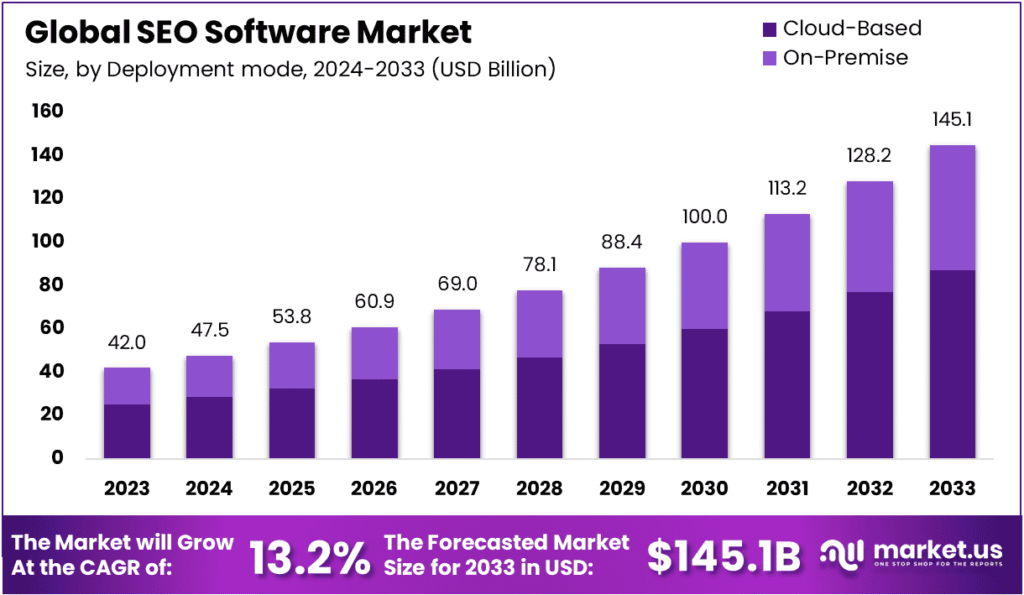The global SEO software market is projected to reach USD 145.1 billion by 2033, up from USD 42 billion in 2023, expanding at a CAGR of 13.2% from 2024 to 2033. The demand for SEO software is significantly influenced by the surge in digital transformation, online competition, and the need for data-driven marketing. Enterprises are prioritizing organic traffic growth, boosting demand for scalable and automated SEO tools. The proliferation of e-commerce, mobile search, and AI integration are reshaping the market landscape. Both SMBs and large enterprises are embracing these solutions to improve SERP rankings and enhance customer acquisition strategies.
Key Takeaways:
-
Market size in 2023: USD 42 billion
-
Expected market size by 2033: USD 145.1 billion
-
CAGR (2024–2033): 13.2%
-
Demand driven by AI, analytics, and digital marketing surge
-
E-commerce and mobile-first strategies boost software adoption
Dominant Market Position
North America currently holds a dominant position in the SEO software market due to high digital maturity, extensive enterprise adoption, and strong presence of tech innovators. The U.S. in particular leads with advanced marketing infrastructure, fueling constant demand for SEO tools. Europe and Asia-Pacific are rapidly catching up, driven by increasing digital business models and startup ecosystems. Enterprise-level SEO adoption is especially strong in sectors like retail, IT, and BFSI. The growing need for multi-lingual and geo-targeted SEO strategies is also boosting the regional footprint of providers. Emerging markets are experiencing fast-paced adoption due to rapid internet penetration and mobile usage.
Technology Perspective
Technological innovations in the SEO software market are centered around AI-driven automation, natural language processing, and predictive analytics. These tools are enabling marketers to streamline keyword research, content optimization, backlink analysis, and competitor benchmarking with minimal manual effort. The integration of machine learning allows platforms to deliver smarter recommendations, personalized insights, and real-time SERP tracking. Cloud-based deployment, API connectivity with CMS platforms, and mobile-first analytics tools are now standard features. Voice search optimization and video SEO capabilities are becoming more prevalent, aligning with shifting user behavior. As Google updates its algorithms, adaptive technology becomes vital for sustained search visibility.
Dynamic Landscap
The SEO software market is dynamic, shaped by algorithm changes, AI innovation, and evolving search behavior. Rapid digital adoption across industries and increased content volume amplify the need for precise SEO tools. Competition intensifies as new entrants innovate pricing and features, pressuring incumbents to evolve faster and stay relevant.
Driver, Restraint, Opportunity, Challenges
Driver: Surge in digital marketing investments.
Restraint: Frequent search engine algorithm updates.
Opportunity: AI integration and voice search optimization.
Challenge: High competition and data privacy concerns.
Use Cases:
-
E-commerce platforms boosting product visibility
-
Enterprises tracking competitor keyword strategy
-
Marketing agencies managing multiple client sites
-
Content creators optimizing blogs and videos
-
Local businesses improving map listings
-
News portals enhancing topical SERP rankings
Key Players Analysis
The competitive landscape is characterized by a mix of established tech giants and innovative startups, offering comprehensive SEO platforms or niche solutions. Market players compete on the basis of usability, integration capabilities, and analytics precision. Their solutions are used across industries including retail, education, finance, and healthcare. Many vendors are transitioning to SaaS models with modular pricing to attract SMEs. R&D investment is focused on automation, AI, and UX improvements. Partnerships with CMS providers and digital marketing firms are helping companies broaden their ecosystem. Scalability, support services, and multi-language capabilities are now key differentiators in enterprise-level adoption.
Recent Developments:
-
Integration of generative AI for SEO content generation
-
Cloud-based keyword clustering and SERP intent tools
-
Expansion into voice and visual search optimization
-
Enhanced APIs for e-commerce platform connectivity
-
Launch of multilingual SEO and localization dashboards
Conclusion:
The SEO software market is on a transformative growth trajectory, fueled by rising digital competition and technological innovation. With AI and automation redefining search strategies, businesses across sizes are leveraging SEO tools to enhance visibility, ROI, and customer engagement. Strategic innovation and adaptability will define the market leaders of the next decade.
Driver, Restraint, Opportunity, Challenges
Driver: Surge in digital marketing investments.
Restraint: Frequent search engine algorithm updates.
Opportunity: AI integration and voice search optimization.
Challenge: High competition and data privacy concerns.
Use Cases:
-
E-commerce platforms boosting product visibility
-
Enterprises tracking competitor keyword strategy
-
Marketing agencies managing multiple client sites
-
Content creators optimizing blogs and videos
-
Local businesses improving map listings
-
News portals enhancing topical SERP rankings
Key Players Analysis
The competitive landscape is characterized by a mix of established tech giants and innovative startups, offering comprehensive SEO platforms or niche solutions. Market players compete on the basis of usability, integration capabilities, and analytics precision. Their solutions are used across industries including retail, education, finance, and healthcare. Many vendors are transitioning to SaaS models with modular pricing to attract SMEs. R&D investment is focused on automation, AI, and UX improvements. Partnerships with CMS providers and digital marketing firms are helping companies broaden their ecosystem. Scalability, support services, and multi-language capabilities are now key differentiators in enterprise-level adoption.
Recent Developments:
-
Integration of generative AI for SEO content generation
-
Cloud-based keyword clustering and SERP intent tools
-
Expansion into voice and visual search optimization
-
Enhanced APIs for e-commerce platform connectivity
-
Launch of multilingual SEO and localization dashboards
- Unlocking Visibility: A Strategic Insight into the SEO Software Market
- The global SEO software market is projected to reach USD 145.1 billion by 2033, up from USD 42 billion in 2023, expanding at a CAGR of 13.2% from 2
- SEO Software Market,
Related posts:
 Machinery and Equipment Industry Email List: Unlocking Opportunities for B2B Marketing Success
Machinery and Equipment Industry Email List: Unlocking Opportunities for B2B Marketing Success
 Essentials Hoodie with Bold Logo – A Modern Streetwear Icon for Everyday Style”
Essentials Hoodie with Bold Logo – A Modern Streetwear Icon for Everyday Style”
 Why Investing in Charlotte SEO Is Crucial for Business Growth
Why Investing in Charlotte SEO Is Crucial for Business Growth
 ways to oversee living where you work ways to oversee living where you work
ways to oversee living where you work ways to oversee living where you work
 Retirement Arranging in Singapore: Retirement Arranging in Singapore:
Retirement Arranging in Singapore: Retirement Arranging in Singapore:
 Transform Your Business with Lahore’s Top Digital Services | Hiline Digital
Transform Your Business with Lahore’s Top Digital Services | Hiline Digital
 Elevate Your Web Applications with Professional Angular JS Development Services
Elevate Your Web Applications with Professional Angular JS Development Services
 Comme des Garcons and Sp5der: Streetwear’s Most Buzziest Brands of 2025
Comme des Garcons and Sp5der: Streetwear’s Most Buzziest Brands of 2025








